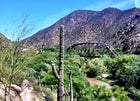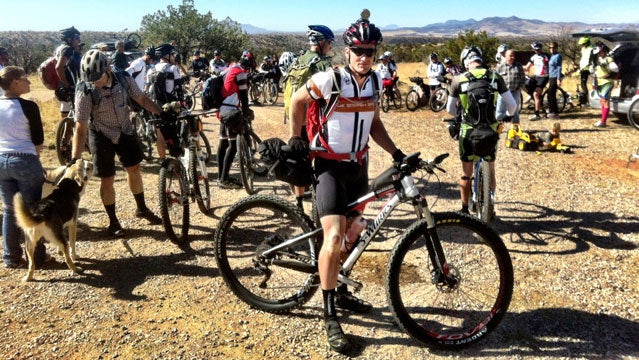In April, I rode 300 miles in a through-push on the Arizona Trail in an that bills itself as “No entry fee, no prizes, absolutely no support.” Friends and family тАФwhy I do any of these endurance races. Everyone acts like thereтАЩs some quick, straightforward answer.

For me the AZT starts with the desert. The Sonoran, that rugged swath of stony, rolling wasteland that sweeps up from the Sierra Madre in Mexico to engulf a chunk of Arizona and southeast California, has captivated me since I first visited a decade ago. Up against the harsh, stripped-down topography, thereтАЩs lush and whimsical flora: cholla that look like topsy-turvy erector sets, sunshine-yellow creosote bushes, and the giant saguaros, which somehow balance between majestic and ridiculous.
When I heard about the (AZTR) a handful of years ago, I knew I had to do it. The full AZTR spans the entire state, but at the time most riders were doing the shorter, 300-mile option from Parker Canyon Lake, just north of the Mexico border, to Superior, Arizona, east of Phoenix.
ItтАЩs predominantly singletrack and follows ascetic rules of self-support: Get yourself to the end, under your own power, and without assistance. I was just starting to dabble in endurance events when I heard about it, but somehow I figured that a couple of 12-hour races and a run on the was preparation enough. I was an athlete and a desert kidтАФwhat could go wrong?
As it turned out, almost everythingтАФfrom some extraordinary food poisoning on my first attempt in 2010 to a GPS failure that left me wandering in desert darkness the following year. Last year, a late-season snowstorm closed Mt. Lemmon, and when I reached 6,500 feet, the officer tasked with enforcing the closure took one look at scrawny, underdressed me, another look at the snow piling up on the blocked highway, and turned me back.
IтАЩm not used to failing, and, dammit, did those DNFs sting. I was demoralized, humiliated. But I also continued to believe that I had a smooth ride in me, so I was drawn back like a jilted lover. Rather than give up, I obsessed.┬а
Before this yearтАЩs AZT300, I pored over maps of the course, weighed myself and my gear, counted calories, and scratched out list after list of mileages, waypoints, water sources, time splits. Going fast on a ride like this requires trimming your kit as small as you dare to save weight while still carrying enough for eventualities.
Some of the more important bits: two spare Slime tubes (as heavy as anchors); a curved industrial needle and dental floss for stitching tire slashes; 5,940 calories and Osmo enough for 600 ounces; Gorilla tape and zip ties; a comb and tweezers to extract cacti from my skin; 20+ hours of light power (plus a backup); an emergency bivvy, and a spare GPS with track.
I sometimes think that you have to like the compulsive planning as much as the riding itself to do these events. When I finally rolled up to Parker Canyon Lake, my setup looked anemic compared to most ridersтАЩ, with my bike at just 34.9 pounds and less than seven pounds on my back.
It was great to see more racers at the start than everтАФ37 for the 300, with another five starting late, and 15 for the full AZTRтАФbut I was so absorbed in my ambitions that I barely noticed. The start was unceremonious as always, a ragtag group filtering into the desert.
One thing I love about this sort of racing is that everyone has their own intentions and designs, from blazing a course record to just surviving. I exchanged a few words with a other racers as I moved past them, filtering through the riders who started early. After just an hour or two, I was on my own, which is how I wanted it. At the risk of sounding grandiose, this was my vision quest, and I needed to do it alone.
The first half of the course, which IтАЩd tried so many times before, became a series of comfortingly familiar landmarks. After just 2.5 miles, I passed the spot where, in 2012 I shredded a sidewallтАФand my confidence. A few miles before Kentucky Camp, just six hours in, I rode by the acacia where my wife and I had encountered a scrum of undocumented immigrants crouching in the shade. At a forest gate near dusk, I remembered stamping around impatiently in 2011 as AZTR record-holder sat and ate a sandwich. тАЬSometimes food just tastes better sitting down,тАЭ heтАЩd said, a platitude thatтАЩs taken me a few years to appreciate.┬а
Everyone thinks that weтАЩre out suffering in these races, but the truth is that the AZT is so replete with twisting, laugh-out-loud singletrack that it mostly feels like fun. I barely stopped in the first 21 hours of racing, and when I found myself an hour early at Molino Campground, low on Mt. Lemmon, I allowed myself a 10-minute nap that felt as restful as a full nightтАЩs sleep.
I climbed higher and soon churned past Windy Point, where IтАЩd been turned around in the snowstorm the previous year. I savored the sun on my arms and the passage into new territory. An hour later, I crested Mt. Lemmon at Summerhaven, where the world’s friendliest waitress packed up a turkey sandwich, two burritos, bread pudding, and four chocolate chip cookies that she pilfered from house-made ice cream sandwiches. She served me the filling in a bowl, and I savored eating fistfuls of vanilla ice cream guilt-free at 9 a.m.
Next came the тАЬTraverse of DeathтАЭ, a thorny, rocky, exposed crest of trail that would offend most goats. It didnтАЩt kill me, but it slowed things to a crawl and inspired a few fits of frustrated cursingтАФespecially when I envisioned my friend Scott Morris, race director and creator of the mapping software he used to plot the course, slamming down the ridge in 3.5 hours en route to a course record the previous year. Five hours later, I reached Oracle.
It was 2 p.m., I was crisping like a Minnesotan retiree in the Arizona sun, and I made my first and only real mistake of the race. I replenished my bottles at a state park landmark called the Kanally House and sped off into the open desert without trying the water. Miles down the trail, I took a draw off my hydration pack, and it tasted like bile. Bad water. I forced myself to drinkтАФI had no real option in the burning sunтАФand became progressively more bloated and sick. Two hours later, I was vomiting beneath a mesquite tree and wondering if I might die in the desert.
As I hunched over and wretched, I momentarily thought of skulking 12 miles back to clean water in Oracle. But if thereтАЩs one thing that IтАЩve learned on the Arizona Trail itтАЩs that nothing is ever as bleak as it seems. So rather than retreat, I eked out a bit of shade for a 40-minute nap. Submission is another thing IтАЩve learned. No matter how tough you are, the desert is tougher, and enduring sometimes means yielding. Before I left Parker Canyon Lake, I accepted that no matter how prepared I was or how determined I felt, I still might not succeedтАФif I didnтАЩt, IтАЩd at least ride away certain that IтАЩd done everything that I could.
When I rose, the relentless heat of the day was abating, and I could move again, if slowly. I inched forward, walking up hills and blundering through wrong turns. Eventually dusk fell, and the relative cool made the fact that I hadnтАЩt had a sip of liquid in hours more tolerable. My mouth felt like it was stuffed with tissues, and I trudged forward and finally reached a road. I came upon a woman hiking in the darkness with no light and an umbrella and thought I was hallucinating, but she told me she was a through-hiker. Not long after, I arrived at the Freeman Water Cache, 18 miles from where I got sick. I drank like Jesus after his 40 days in the desert. Then I lay down and slept another 40 minutes. When I woke it was midnight and chilly, and I felt as if IтАЩd been resurrected. Time to ride.
After Freeman comes a section called The Boulders, which trends gently downhill and is rollercoaster fast. My legs warmed and I pistoned forward like I hadnтАЩt in ten hours. The saguaros were shadowy figures urging me forward in the night, and my lights glinted like diamond pinpricks off the eyes of tarantulas, which balled up and recoiled as I zoomed past. I trailed a skunk for a quarter of a mile, then I had to lock up my brakes to avoid a coyote sitting in my path. She stared at me and didnтАЩt budge for what felt like an eternity until I finally yipped at her so I could move forward. I sang out loud and counted falling stars, and before I knew it I was at the Gila River and the skyline was sharpening with the cobalt hues of morning. One final, 35-mile push remained.
The passage from Kelvin, on the Gila River, to Superior is the only section of the AZT300 that I hadnтАЩt ridden before. I was both excited and unnerved about not knowing what lay ahead. The trail zigged and zagged along the river for a few hours then turned north through a forest of saguaros as big as missile silos and scrambled sharply into a range of toothy mountains. I should have loathed and cursed this grinding climb in my depleted state, but the trail was so well built and the surroundings so enticing that I simply pedaled upward in awe.
At a high saddle, I looked down into a hanging valley and knew that this was what IтАЩd been riding toward for four years. It was a private, unspoiled place, with shields of golden rock piercing the scraggly mountains and a ribbon of trail snaking along the ridge sides to the horizon. I often tell people that I go into the wilderness to affirm that such places exist, which is true, but that doesn’t explain racing. In taking on the AZT, I realized that I ride hard to test myself and to build fortitudeтАФafter a four-year opus like this, insurance hassles and speeding tickets and all the other day-to-day headaches that once seemed a big deal now feel like mere trifles. Solitude and relentless exertion sharpen the vision so I can see both the immense and humbling spacesтАФas well as myselfтАФmore clearly.
It took more than an hour to slash down the meandering, rocky trails that lead from the far side of the hanging valley to the finish of the race at Picket Post trailhead. I stopped the clock in 51 hours and 59 minutes, .┬а More importantly, I was certain that, though it hadnтАЩt been a perfect run, IтАЩd done everything that I could.
I was relieved that there was nothing waiting for me in the dusty parking lotтАФno people, no backslaps, no commotion. It was just me and the burning bright desert.


